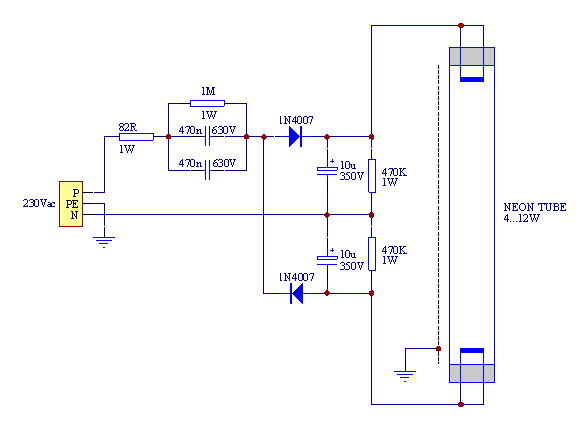


Fluorescent tubes are often powered with AC current, but with this circuit we will
drive it in DC. Basically this circuit is a voltage doubler (composed by the two
diodes 1N4007 and the two high voltage electrolytic capacitors of 10 uF -
350 V) that generates, when the tube is off, a DC voltage of more than
600 V from a 230 Vac main. Unfortunately this circuit doesn’t work with a
110 Vac main. If a low power tube is used (for example 4, 8 or 12 W)
these 600 V are enough to strike the it.
Once the tube lit, a current starts flowing through the two capacitors of
470 nF - 630 V that causes a voltage drop that ensures the service
voltage of about 30 V for the tube.
The 1 MOhm resistor and the two 470 kOhm resistors are useful for
discharging the capacitors when the circuit is switched off. If not discharged,
the energy stored in the capacitors could be lethal even when the circuit is
unplugged. Since the lamp is directly connected to the main, one should avoid
touching any part of it and be very careful anyway.
The 82 Ohm resistor is used to reduce the current spike when the circuit
is switched on and all the capacitors are discharged.
A metal plate near the tube and connected to the ground make easier to start
the tube.

Since in this case the electrodes are not heated, starting the tube can be a
little difficult when the lamp is old or too long. Touching the tube with one
hand usually helps (with a little help of my hand I could light a 22 W
tube).
When the lamp is lit, one can remark that the negative electrode (in the picture
on the right) is darker than the positive one: this is due to the Faraday
dark zone, that is only visible when the tube is powered with DC
current.



| Back to the index. | 
| Back to the home page. | 
| Previous page. |


| Questa pagina è anche disponibile in italiano. |
